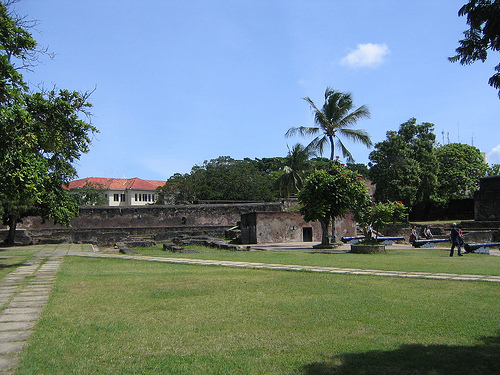

Location: Nkrumak Rd, Mombasa Map
Tel. 041 2225 934
Open: 8am- 6pm daily
Constructed: 1593

Fort Jesus was constructed in 1593 on the orders of king of Philip II of Spain also known as king Philip I of Portugal. It is located on the strategic grounds and served in defence of the ships stationed in the harbor. Through its long and bloody history the citadel switched ownership between nine forces in the region. Today it holds a museum. Among other things you can see remains of a military Portuguese ship.
Although the Portuguese first appeared in East
Africa at the end of the 15th century, their presence there grew
only gradually. The Portuguese colonies were constantly attacked by
the Turks who dominated the region. The impetus for the construction
of a modern fortress in Mombasa was the Turkish raids of 1585 and
1589. As a result, in 1593, the five-tower Fort Jesus was founded in
Mombasa, and by 1596 the Italian architect Giovanni-Battista Kairati
completed its construction. The fort was built from local coral on a
cliff near the harbor, which was visited by Portuguese warships and
merchant ships.
Mombasa, as the stronghold of the Portuguese
presence in East Africa, throughout the 17th century was at the
center of constant hostilities. It was first captured by the local
Sultan Yusuf bin Hassan (who had previously been baptized as Geronim
Shinguuli) in 1631. The Sultan killed the Portuguese commandant and
killed the entire Portuguese population of Mombasa, including 70
children. The city, and with it Fort Jesus, passed from hand to hand
nine times. Among other things, the fort, whose walls successfully
withstood the fire of the then artillery, withstood an almost
three-year siege of the Omani forces in 1696-1698. The entire
garrison of the fortress perished (not so much from enemy fire as
from diseases), and the last surviving defender lured the enemy
soldiers to the powder magazine and exploded with them.
In
1728, the Portuguese managed to return briefly to Mombasa, but their
domination did not last long. A year later, without waiting for
reinforcements from the mother country, Fort Jesus fell again and
the power in East Africa passed to the Turks for a century and a
half. Since 1837, the fort was used as a barracks. However, in 1875,
Fort Jesus was attacked by the British gunboats Nassau and Rifleman.
After an artillery duel, the fort was taken by storm, the era of
British rule in East Africa began. In 1895, Kenya was proclaimed a
British colony.
Under the British, Fort Jesus turned into a
prison for especially dangerous criminals for 60 years. He performed
this function almost until the recognition of Kenya’s independence,
and only on October 24, 1958 received the status of a national park.
After excavations at the fort, a museum was opened. In 2011, the
35th session of the UNESCO World Heritage Committee included Fort
Jesus on the World Heritage List.
Construction
Fort Jesus covers an area of 2.36 hectares, in
shape approaching a square with a side of 150 meters. In accordance
with the spirit of the times, the original construction of the fort
reflected the principles of Renaissance architecture with its focus
on the proportions of the human body as an example of harmony.
Frommer's guidebook calls the fort the best work of Kairati,
comparing a fort dug into a coral rock with a human torso, four
bastions with hands, and an advanced fortification made outside the
walls with his head. The whole structure was aimed, firstly, at
defense by small forces, and secondly, at hiding the insignificance
of these forces from the enemy.
After the Muslims finally
conquered the fort at the end of the 17th century, its restructuring
began. The church was destroyed, a 23-meter-deep well was dug, where
sea water used for washing was accumulated. The Arabs built the
15-meter-high walls of the fort another three meters in height.
Nevertheless, the original architecture was largely preserved, and
so much so that during the restoration of 1990 an untouched grave of
a Portuguese soldier was discovered in one of the walls. During the
restoration, materials are used that correspond to those used for
the construction of Giovanni-Battista Kairati - petrified coral and
lime mortar. The moat along the walls of the fort, distant from the
sea, is currently filled up, but the condition of the walls and
towers is assessed as good.
In the central part of the fort,
in a more modern building, which previously served as a barracks for
soldiers of the British garrison, there is a museum, among the
exhibits of which are shards of china and other finds from sunken
ships of the Portuguese rule. Older buildings in the interior of the
fort are almost destroyed, among the best-preserved structures are
the ruins of a Portuguese chapel.